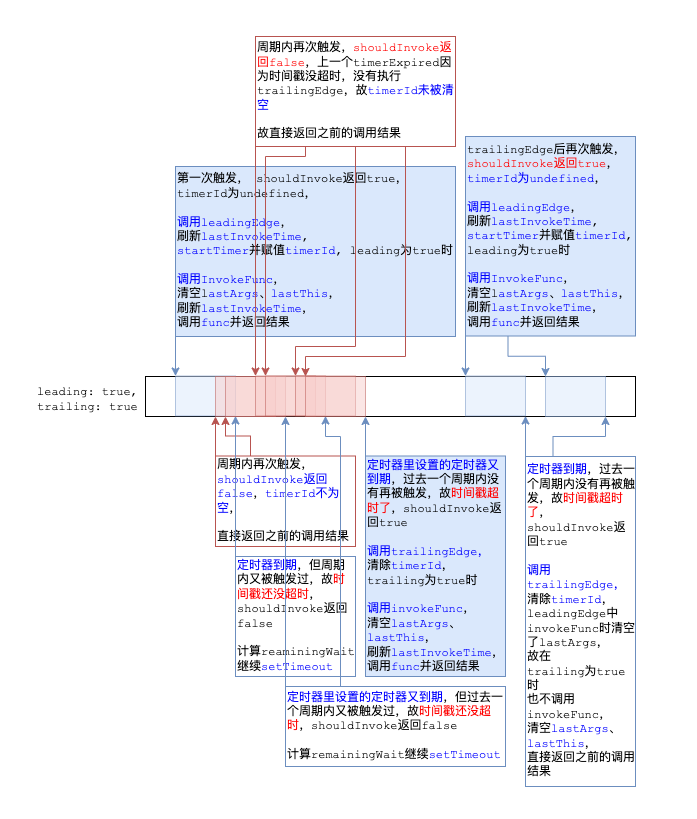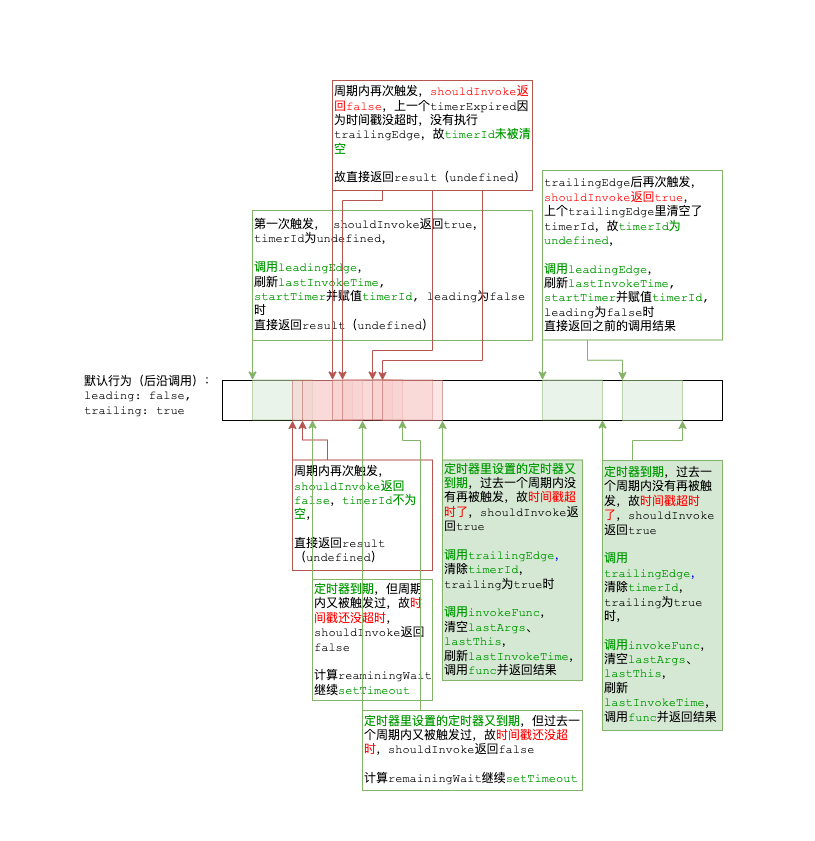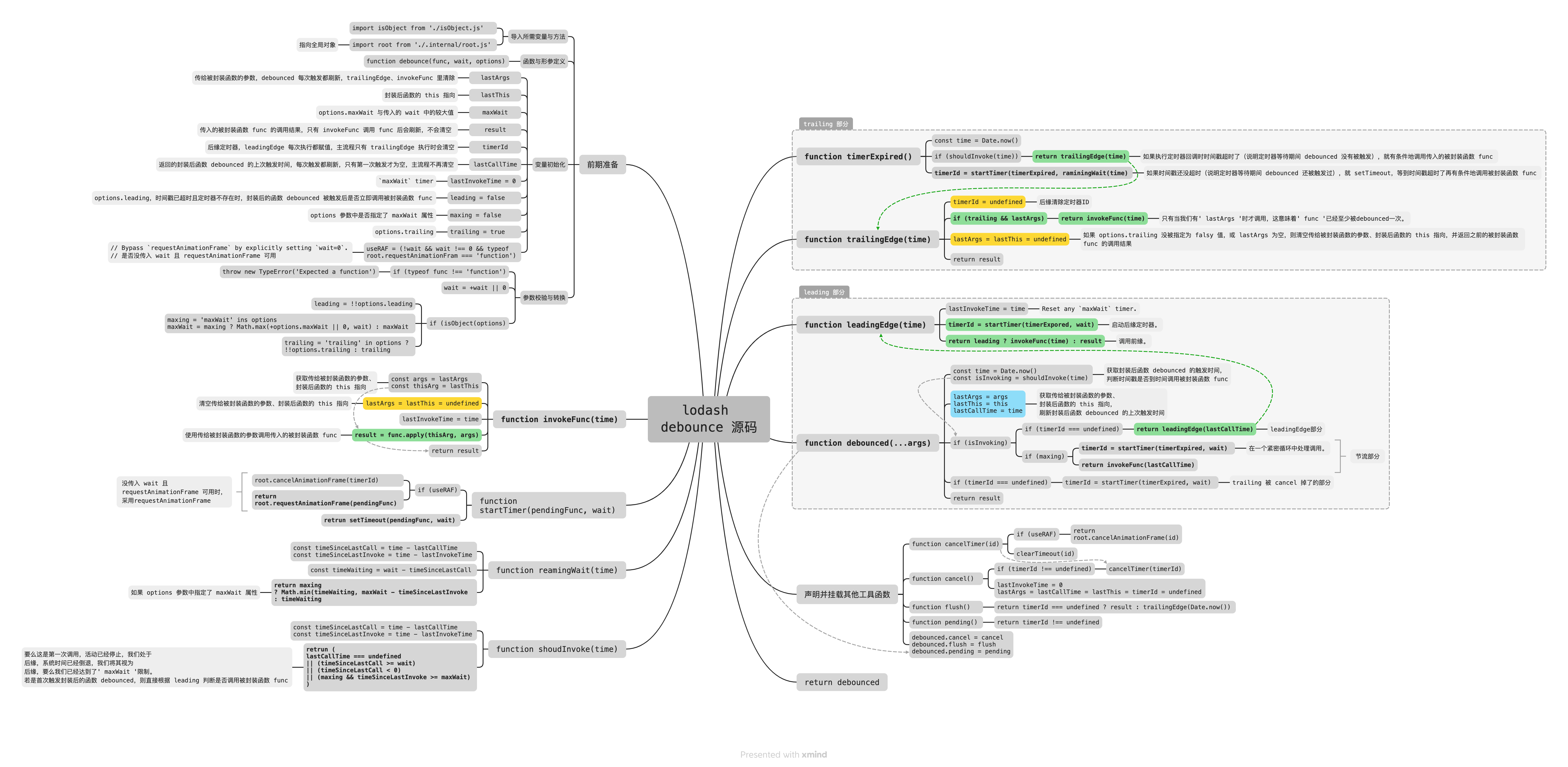0x00 前言
复杂的地方主要是 debounce 的主流程部分,故 cancel、flush、pending 以及 throttle 部分大部分都略过
完整源码与注释可参考该 PR:https://github.com/NEPTLIANG/lodash-source-code-interpretation/pull/1/files
0x01 源码及注释
导入及文档注释
首先是引用了一个 isObject 函数和一个 root 常量:
import isObject from './isObject.js'
import root from './.internal/root.js' //指向全局对象
isObject 自然是字面意思,root 是指向全局对象的。这两个最后再简析下
然后是文档注释,合起来机翻一手并分割对应到各行
/**
* Creates a debounced function that delays invoking `func` until after `wait`
* 创建一个debound函数,该函数将延迟调用' func ',直到上次调用debound函数后的' wait '毫秒之后,
* milliseconds have elapsed since the last time the debounced function was
* invoked, or until the next browser frame is drawn. The debounced function
* 或者直到绘制下一个浏览器帧。debented函数
* comes with a `cancel` method to cancel delayed `func` invocations and a
* 带有一个“cancel”方法来取消延迟的“func”调用和一个
* `flush` method to immediately invoke them. Provide `options` to indicate
* “flush”方法来立即调用它们。提供' options '来指示
* whether `func` should be invoked on the leading and/or trailing edge of the
* ' func '是否应该在' wait '超时的前沿和/或后沿调用。
* `wait` timeout. The `func` is invoked with the last arguments provided to the
* ' func '被使用提供给debound函数的上一个参数来调用。
* debounced function. Subsequent calls to the debounced function return the
* 对 debounced 函数的后续调用将返回
* result of the last `func` invocation.
* 最后一次' func '调用的结果。
*
* **Note:** If `leading` and `trailing` options are `true`, `func` is
* **注意:**如果' leading '和' trailing '选项为' true ',则' func '
* invoked on the trailing edge of the timeout only if the debounced function
* 只在' wait '超时期间多次调用debounced函数时才会在超时的后缘调用。
* is invoked more than once during the `wait` timeout.
*
* If `wait` is `0` and `leading` is `false`, `func` invocation is deferred
* 如果 wait 为 0 且 leading 为 false,则 ' func '调用将被延迟
* until the next tick, similar to `setTimeout` with a timeout of `0`.
* 到 the next tick,类似于 timeout 为 0 的 setTimeout。
*
* If `wait` is omitted in an environment with `requestAnimationFrame`, `func`
* 如果在使用requestAnimationFrame的环境中忽略了' wait ', ' func '
* invocation will be deferred until the next frame is drawn (typically about
* 调用将被延迟到绘制下一帧(通常约16ms)。
* 16ms).
*
* See [David Corbacho's article](https://css-tricks.com/debouncing-throttling-explained-examples/)
* 参见[David Corbacho的文章](https://css-tricks.com/debouncing-throttling-explained-examples/)
* for details over the differences between `debounce` and `throttle`.
* ,了解' debounce '和' throttle '之间的区别。
*
* 创建一个debound函数,该函数将延迟调用' func ',直到上次调用debound函数后的' wait '毫秒之后,
* 或者直到绘制下一个浏览器帧。debented函数
* 带有一个“cancel”方法来取消延迟的“func”调用和一个
* “flush”方法来立即调用它们。提供' options '来指示
* ' func '是否应该在' wait '超时的前沿和/或后沿调用。
* ' func '使用提供给debound函数的最后一个参数来调用。
* 对该函数的后续调用将返回
* 最后一次' func '调用的结果。
*
* **注意:**如果' leading '和' trailing '选项为' true ',则' func '
* 只在' wait '超时期间多次调用debounced函数时才会在超时的后缘调用。
*
* 如果' wait '为' 0 '、' leading '为' false ', ' func '调用将被延迟
* 到下一次滴答,类似于' setTimeout '的超时为' 0 '。
*
* 如果在使用requestAnimationFrame的环境中忽略了' wait ', ' func '
* 调用将被延迟到绘制下一帧(通常约16ms)。
*
* 参见[David Corbacho的文章](https://css-tricks.com/debouncing-throttling-explained-examples/)
* ,了解' debounce '和' throttle '之间的区别。
*
* @since 0.1.0
* @category Function
* @param {Function} func The function to debounce.
* @param {number} [wait=0]
* The number of milliseconds to delay; if omitted, `requestAnimationFrame` is
* used (if available).
* @param {Object} [options={}] The options object.
* @param {boolean} [options.leading=false]
* Specify invoking on the leading edge of the timeout.
* 指定在超时的前沿上调用。
* @param {number} [options.maxWait]
* The maximum time `func` is allowed to be delayed before it's invoked.
* ' func '被调用前允许延迟的最大时间。
* @param {boolean} [options.trailing=true]
* Specify invoking on the trailing edge of the timeout.
* 指定在超时后缘上调用。
* @returns {Function} Returns the new debounced function.
* @example
*
* // Avoid costly calculations while the window size is in flux.
* // 避免在窗口大小变化时进行昂贵的计算。
* jQuery(window).on('resize', debounce(calculateLayout, 150))
*
* // Invoke `sendMail` when clicked, debouncing subsequent calls.
* // 单击时调用' sendMail ',debouncing 后续调用。
* jQuery(element).on('click', debounce(sendMail, 300, {
* 'leading': true,
* 'trailing': false
* }))
*
* // Ensure `batchLog` is invoked once after 1 second of debounced calls.
* // 确保 `batchLog` 在 1 秒的 debounced 调用后被调用一次。
* const debounced = debounce(batchLog, 250, { 'maxWait': 1000 })
* const source = new EventSource('/stream')
* jQuery(source).on('message', debounced)
*
* // Cancel the trailing debounced invocation.
* // 取消尾随的 debounced 调用。
* jQuery(window).on('popstate', debounced.cancel)
*
* // Check for pending invocations.
* // 检查挂起的调用。
* const status = debounced.pending() ? "Pending..." : "Ready"
*/
声明 debounce 函数及闭包需要的变量
function debounce(func, wait, options) {
let lastArgs, // 传给被封装函数的参数,debounced 每次触发都刷新,trailingEdge、invokeFunc 里清除
// 封装后函数的 this 指向
lastThis,
// options.maxWait 与传入的 wait 中的较大值
maxWait,
// 传入的被封装函数 func 的调用结果,只有 invokeFunc 调用 func 后会刷新,不会清空
result,
// 后缘定时器,leadingEdge 每次执行都赋值,主流程只有 trailingEdge 执行时会清空
timerId,
// 返回的封装后函数 debounced 的上次触发时间,每次触发都刷新,只有第一次触发才为空,主流程不再清空
lastCallTime
// `maxWait` timer
let lastInvokeTime = 0
/* options.leading,时间戳已超时且定时器不存在时,封装后的函数 debounced 被触发后
是否立即调用被封装函数 func */
let leading = false
// options.trailing
let trailing = true
// options 参数中是否指定了 maxWait 属性
let maxing = false
校验并转换参数类型
// Bypass `requestAnimationFrame` by explicitly setting `wait=0`.
// 是否 wait 为空且 requestAnimationFrame 可用
const useRAF = (!wait && wait !== 0 && typeof root.requestAnimationFrame === 'function')
if (typeof func !== 'function') {
throw new TypeError('Expected a function')
}
wait = +wait || 0
// import isObject from './isObject.js'
if (isObject(options)) {
leading = !!options.leading
maxing = 'maxWait' in options
maxWait = maxing ? Math.max(+options.maxWait || 0, wait) : maxWait
trailing = 'trailing' in options ? !!options.trailing : trailing
}
声明用于调用 func 的 invokeFunc
/**
* 调用传入的被封装函数 func,清空传给被封装函数的参数、封装后函数的 this 指向
* @param {number} time
* @returns 传入的被封装函数 func 的调用结果
*/
function invokeFunc(time) {
// 获取传给被封装函数的参数
const args = lastArgs
// 获取封装后函数的 this 指向
const thisArg = lastThis
// 清空传给被封装函数的参数、封装后函数的 this 指向
lastArgs = lastThis = undefined
lastInvokeTime = time
// 使用传给被封装函数的参数调用传入的被封装函数 func
result = func.apply(thisArg, args)
return result
}
声明用于设置计时器的 startTimer
/**
* setTimeout / requestAnimationFrame
* @param {Function} pendingFunc 定时器到期后的回调
* @param {number} wait 封装函数传入的 wait
* @returns {number} timer ID
*/
function startTimer(pendingFunc, wait) {
// 没传 wait 且 requestAnimationFrame 可用时,采用requestAnimationFrame
if (useRAF) {
root.cancelAnimationFrame(timerId)
return root.requestAnimationFrame(pendingFunc)
}
return setTimeout(pendingFunc, wait)
}
声明重开计时器时用于计算剩余等待时长的 remainingWait
/**
* 定时器回调中重开定时器时计算剩余等待时长
* @param {number} time 返回的封装后函数 debounced 的触发时间
* @returns {Number} 剩余等待时长
*/
function remainingWait(time) {
const timeSinceLastCall = time - lastCallTime
const timeSinceLastInvoke = time - lastInvokeTime
const timeWaiting = wait - timeSinceLastCall
return maxing //如果 options 参数中指定了 maxWait 属性
? Math.min(timeWaiting, maxWait - timeSinceLastInvoke)
: timeWaiting
}
声明用于根据时间戳判断是否到时候调用 func 的 shouldInvoke
/**
* 判断时间戳是否到时候调用传入的被封装函数 func
* @param {number} time 封装后函数 debounced 的触发时间
* @returns {boolean} 是否到时候调用被封装函数 func
*/
function shouldInvoke(time) {
const timeSinceLastCall = time - lastCallTime
const timeSinceLastInvoke = time - lastInvokeTime
// Either this is the first call, activity has stopped and we're at the
// 要么这是第一次调用,活动已经停止,我们处于
// trailing edge, the system time has gone backwards and we're treating
// 后缘,系统时间已经倒退,我们将其视为
// it as the trailing edge, or we've hit the `maxWait` limit.
// 后缘,要么我们已经达到了' maxWait '限制。
return (
lastCallTime === undefined //若是首次触发封装后的函数 debounced,则直接根据 leading 判断是否调用被封装函数 func
|| (timeSinceLastCall >= wait)
|| (timeSinceLastCall < 0)
|| (maxing && timeSinceLastInvoke >= maxWait)
)
}
声明定时器到期后的回调 timerExpired
/**
* 定时器到期后的回调
* @returns {unknown}
*/
function timerExpired() {
const time = Date.now()
if (shouldInvoke(time)) { //如果执行定时器回调时时间戳超时了(说明定时器等待期间 debounced 没有被触发),就有条件地调用传入的被封装函数 func
return trailingEdge(time)
}
// 如果时间戳还没超时(说明定时器等待期间 debounced 还被触发过),就 setTimeout,等到时间戳超时了再有条件地调用被封装函数 func
// Restart the timer.
timerId = startTimer(timerExpired, remainingWait(time))
}
声明防抖前沿的操作 leadingEdge
/**
* debounced 被触发时,如果时间戳到时间调用函数且定时器不存在,setTimeout 并根据 options.leading
* 判断是否立即调用传入的被封装函数 func
* @param {number} time 返回的封装后函数 debounced 的触发时间
* @returns `options.leading ? 调用函数返回的结果 : 上次调用返回的结果`
*/
function leadingEdge(time) {
// Reset any `maxWait` timer.
lastInvokeTime = time // /*?*/ 疑问:不明白为何要在 leadingEdge 里刷新 lastInvokeTime。 答:为了在 leading: false 的时候也能正确判断是否 shouldInvoke,如果只在 invokeFunc 里刷新,则 leading: false 时即使第二次触发还没到 maxWait,time - lastInvokeTime 也可认为必然 > maxWait,shouldInvoke 也会返回 true
// Start the timer for the trailing edge.
// 启动后缘定时器。
timerId = startTimer(timerExpired, wait)
// Invoke the leading edge.
// 调用前缘。
return leading ? invokeFunc(time) : result
}
声明防抖后沿操作 trailingEdge
/**
* 定时器回调执行时时间戳超时的操作,清除定时器ID、保存的参数与 this 指向,
* 有条件地调用传入的被封装函数 func,否则返回之前的调用结果
* @param {number} time 定时器回调执行时的时间戳
* @returns 传入的被封装函数 func 调用结果或之前的调用结果
*/
function trailingEdge(time) {
// 后缘清除定时器ID
timerId = undefined
// Only invoke if we have `lastArgs` which means `func` has been
// debounced at least once.
// 只有当我们有' lastArgs '时才调用,这意味着' func '已经至少被
// debounced一次。
if (trailing && lastArgs) { //? 疑问:为何要判断 lastArgs
return invokeFunc(time)
}
/* 如果 options.trailing 没被指定为 falsy 值,或 lastArgs 为空,则清空
传给被封装函数的参数、封装后函数的 this 指向,并返回之前的被封装函数 func 的调用结果 */
lastArgs = lastThis = undefined //? 疑问:为什么 trailingEdge 一定要清除 lastArgs 而 leadingEdge 只有执行 func 才清除
return result
}
声明挂到 debounced 函数上的一些其他方法
-
cancelfunction cancelTimer(id) { if (useRAF) { return root.cancelAnimationFrame(id) } clearTimeout(id) } function cancel() { if (timerId !== undefined) { cancelTimer(timerId) } lastInvokeTime = 0 lastArgs = lastCallTime = lastThis = timerId = undefined } -
flushfunction flush() { return timerId === undefined ? result : trailingEdge(Date.now()) } -
pendingfunction pending() { return timerId !== undefined }
声明封装操作返回的函数 debounced
其中可分为以下几个部分:
-
根据时间戳与是否首次触发判断是否该调用
func了,并刷新闭包里的各个变量/** * 封装操作返回的函数 * @param {...any} args 传给被封装函数的参数 * @returns {Function} 返回封装好的函数 */ function debounced(...args) { // 封装后函数 debounced 的触发时间 const time = Date.now() // 时间戳是否到时间调用被封装函数 func const isInvoking = shouldInvoke(time) // 获取传给被封装函数的参数 lastArgs = args // 获取封装后函数的 this 指向 lastThis = this // 刷新封装后函数 debounced 的上次触发时间 lastCallTime = time if (isInvoking) { -
leadingEdge部分的逻辑/* leadingEdge部分: 如果时间戳到时间调用被封装函数 func,且不存在定时器( 意味着: 1. 封装返回的函数 debounced 首次被触发, 2. 或 trailingEdge 执行过 ),则 setTimeout 并根据 options.leading 判断是否立即调用传入的被封装函数 func */ if (timerId === undefined) { return leadingEdge(lastCallTime) } -
节流部分的逻辑
/* 节流部分: 如果时间戳到时间调用被封装函数 func,但定时器还存在,(意味着是节流的判断结果为 true) 且 options 中指定了 maxWait, 则以 wait 时长 setTimeout 刷新定时器,并立即调用一次被封装函数 func */ if (maxing) { // Handle invocations in a tight loop. // 在一个紧密循环中处理调用。 timerId = startTimer(timerExpired, wait) return invokeFunc(lastCallTime) } // 如果进了这个块但是没进上面两个块,则属于系统时间回拨情况,下面的 if 也不会符合,直接到 return -
debounced函数的cancel方法被调用过后再次触发debounced的情况处理} /* 如果时间戳还没到时间调用被封装函数 func,且不存在定时器,( 意味着定时器回调调用过 trailingEdge,且封装返回的函数 debounced 不是首次被触发, 即 trailing 被 cancel 掉了 )就 setTimeout */ if (timerId === undefined) { timerId = startTimer(timerExpired, wait) } -
还没到点调用
func或系统时间回拨情况下都直接return result/* 如果时间戳还没到时间调用被封装函数 func 或( 时间戳到了时间调用 func,且定时器存在且 options 中没指定 maxWait,即系统时间回拨 ),就直接返回之前的调用结果 */ return result } -
把几个方法挂到
debounced函数上,并返回之debounced.cancel = cancel debounced.flush = flush debounced.pending = pending return debounced } export default debounce
0x02 流程图
把源码读了一遍之后还是云里雾里的,于是照着源码大致画了个流程图

大概可以看出整个流程基本可以大致分为三个部分:
debounced函数被触发时,对leadingEdge的调用(图中蓝色部分)- 计时器到期后(
timerExpired被调用时),对trailingEdge的调用(图中绿色部分) - 以上两部分逻辑对
invokeFunc等通用方法的调用(图中黄色部分)
0x03 时序图(大概
照着源码画了流程图后还是有点困惑,于是画了几个类似时序图的图,分别分析了 leading 与 trailing 的三种情况组合。(由于每次触发都会刷新 lastCallTime 和 lastArgs,所以图里没写)
-
leading和trailing都为true
可知
- 连续触发的时候
- 前沿和后沿都会调用
func(蓝底部分) - 中间的触发全部略过、定时器到期回调也全是
setTimeout到时间戳到期
- 前沿和后沿都会调用
- 只触发一次的时候,
- 只有前沿会调用
func - 后沿因为前沿清空了
lastArgs不再调用,不知是何用意,看起来似乎是为了避免用同一批参数两次调用func
- 只有前沿会调用
- 连续触发的时候
-
leading: false, trailing: true:后沿调用,即默认行为
可知
- 无论
leading是true还是false,前沿都会调用leadingEdge,都会startTimer - 只是为
false时不调用func
- 无论
-
leading: true, trailing: false:前沿调用
可知
- 无论
trailing是true还是false,后沿也都会调用trailingEdge,都会清空timerId、lastArgs、lastThis - 只是为
false时不调用func
- 无论
0x04 思维导图(大概
画时序图分析过后又画了个脑图整理了下流程,因为有合并子节点的操作,所以采用表格形式:

黄的是条件的分支,红绿蓝的是各步操作,灰的是所属场景的总结
0x05 源码的思维导图
最后画了个脑图整理了下源码的结构

0x06 简析 throttle
debounce 主流程理清之后,throttle 的逻辑也就比较清晰了,VS Code 中跟踪各个 throttle 相关的配置项可以知道,throttle 主要是增加了:
leadingEdge与invokeFunc中刷新lastInvokeTime- 判断
shouldInvoke时候在对timeSinceLastCall与wait比较的基础上增加对timeSinceLastInvoke与maxWait的比较 - 计算
remainingWait时候取wait - timeSinceLastCall与maxWait - timeSinceLastInvoke中的较小者 debounced中添加timeSinceLastInvoke超时情况对应的处理逻辑:if (isInvoking)中的if (maxing)部分
0x07 简析引入的 isObject、root
isObject
- 先排除
null - 然后判断
typeof返回的是不是object或function
function isObject(value) {
const type = typeof value
return value != null && (type === 'object' || type === 'function')
}
root
-
.internal/root.js:
const freeGlobal = typeof global === 'object' && global !== null && global.Object === Object && global export default freeGlobal -
.internal/root.js
import freeGlobal from './freeGlobal.js' /** Detect free variable `globalThis` */ const freeGlobalThis = typeof globalThis === 'object' && globalThis !== null && globalThis.Object == Object && globalThis /** Detect free variable `self`. */ const freeSelf = typeof self === 'object' && self !== null && self.Object === Object && self /** Used as a reference to the global object. */ const root = freeGlobalThis || freeGlobal || freeSelf || Function('return this')()
即依次对
globalThis、global、self
进行以下两步判断:
- 是对象且不是
null - 其
Object属性指向全局作用域下的对象构造函数Object
一旦遇到满足条件的就返回之,否则返回一个新构建的函数里返回的 this
0x08 存在的疑问
一行行读过源码、画图分析过流程与行为,问过 New Bing 和 ChatGPT 3.5,还是有几个问题整不明白,故先在此记录下:
- 不是很明白为什么
trailingEdge在invokeFunc前要判断lastArgs - 不是很明白为什么
trailingEdge一定要清除lastArgs而leadingEdge只有执行func才清除
0xff 参考资料
- lodash@GitHub《lodash》(https://github.com/lodash/lodash)
- 梁王@掘金《每日源码分析 - lodash(debounce.js和throttle.js)》(https://juejin.cn/post/6844903536157786120)
- 鹤云云@掘金《lodash源代码解析—— debounce & throttle》(https://juejin.cn/post/6934149265153343496)
- HeftyKoo@GitHub《lodash源码分析之debounce》(https://github.com/HeftyKoo/pocket-lodash/issues/174)
//End of Article
